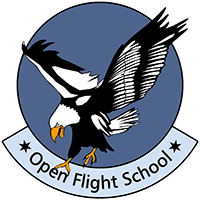Basics for Radio Communication
3. The Golden Rules
3.3. Reference Points and Relative Position Reporting
![By Saschaporsche [CC BY-SA 3.0 (https://creativecommons.org/licenses/by-sa/3.0)], from Wikimedia Commons](https://www.openflightschool.de/pluginfile.php/610/mod_book/chapter/287/640px-Navigation_Display_%28ND%29_on_Boeing_747-400.jpg) The best radio message is worth nothing if it is not clear to which position a direction refers.
The best radio message is worth nothing if it is not clear to which position a direction refers.
An example: Someone has lost his way and reports to the tower "I am left of the big city".
Actually quite simple, you think at first. Unfortunately it can be everywhere, because it is not known on which course the aircraft is flying. If he is flying south and has the city on the left, then he is more likely to be west of the city. Conversely, if he is flying north and has the city on his left, then he is east of the city. And besides it is not yet clear which city he actually means.
It is therefore very important for the receiver to know from which position the report of the direction is made.
Another example: A pilot reports that there are many enemy aircraft in the east.
Again supposedly precise and yet very inaccurate. First of all, who reported it and where are they? And even from there, east is a broad term: how far east?
As we see it is really important to communicate precisely where you are and in which direction applies to the report.
Next example: "Green Leader, Green 2, contact at 3 o'clock, high, close."
A Wingman reports a contact right above and close to his leader. This also sounds very precise at first, but requires that both fly the same course and not far away from each other, which will not always be the case even with well-rehearsed manoeuvres.
"Green Leader, Green 2, contact on your 3 o'clock, high, close." This is already really precise, but assumes that the wingmen can estimate accurately and estimates the position of the contact from the point of view of his flight leader.
To make a long story short, there is no panacea for this problem, at least not on a pure radio basis.
Modern fighter aircraft can locate enemies by radar and constantly exchange the positions of their own aircraft as well as those of recognized contacts by data link and keep them up to date. This allows every pilot to see at a glance what is going on around himself by using instruments and displays.
Bullseye
This is not possible with fighter planes from before 1980. Only precise radio communication and a known reference point adapted to the situation can help here. The so-called “Bullseye” reference point has proven to be a common procedure.
The Bullseye is a defined point of reference that only your own troops know. You could take any point on the map, e.g. a city name, but if the enemy hears the radio, he can interpret the position you are reporting. Therefore you take the neutral code name “Bullseye” even if the city is the point. Now the enemy has no idea where the “Bullseye” is or how to interpret the received radio messages.
All data refers to this one point. In a large area of application, however, this can become inaccurate with increasing distance from the bullseye, as the distance between angle divisions increases. Modern fighter planes can search with their radar and easily find a contact. Old aircraft without radar have to rely on the pilot's eyes. The less air space he has to search, the better. Here a good method is to have several clearly defined reference points in one area of operation and then to use the most adjacent one.
This topic will play an essential role in the practice of air combat in WWII as well as in Korea and even in modern warfare. It will therefore be expanded later in a further theoretical courses. For the moment we want to leave it at the above.
